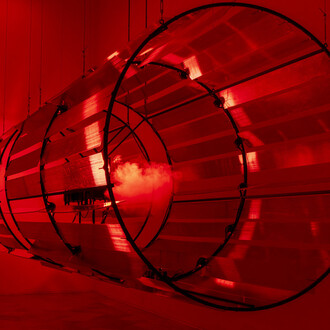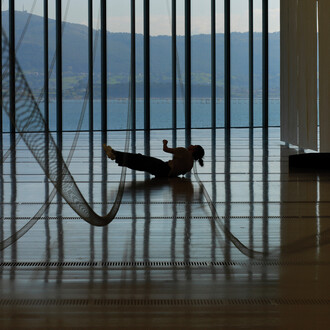Donna Huanca’s Las niñas del altiplano marks the second chapter of her first exhibition at the gallery in 2017, Lengua de Bartolina Sisa, in Madrid. That earlier work honored the 18th century Aymara revolutionary who resisted Spanish colonial rule and whose brutal execution and dismemberment embodied a historical trauma imposed on Indigenous bodies. In that installation, Huanca rendered mourning through pigments, performance, and cartographic maps as abstraction. Her gesture was not only commemorative but regenerative—mapping erasure and imagining its undoing.
In Las niñas del altiplano, Huanca turns her focus toward the sovereign reconstruction of the feminine body and psyche, exploring how childhood, mythology, and ritual serve as tools for resistance, healing, and futurity. The title itself su!ests a reimagining of the body through high- altitude cosmology, rooted in the Andean landscape yet projected outward into speculative space. The niñas here are not passive or symbolic figures; they are agents of cosmic and material sovereignty.
The gallery’s architecture is transformed into a soft, immersive space with white translucent cellophane, reshaping the space into a porous skin or sanctum—a hybrid between the artist’s studio and a metaphysical womb. Within this environment, Huanca presents a series of large-scale paintings composed of thickly layered oil, pigment, and skin-like textures. These works function as topographical maps of the body, embedded with braids, flesh tones, and corporeal residue. Their dense, layered surfaces evoke both geological terrain and psychic landscape, where sovereignty is not fixed, but sedimented—an accumulation of gesture, memory, and disruption.
Interspersed throughout the space are sculptural forms composed of aluminum, clay, and transparent materials. These aluminum works operate as inverted paintings: sculptural surfaces that record the artist’s bodily gestures made during the act of painting. Each surface captures the residual imprint of performance—a material echo of Huanca’s somatic presence. The sculptures do not simply occupy space; they disrupt and reorganize it.
A layered soundscape circulates throughout the installation, composing an ambient and elemental vibration. Sound functions as an invisible architecture, a vehicle of ancestral transmission and atmospheric power. Inside the heart of the exhibition lies a portal, inspired by the pre-Columbian ceremonial site of Pumapunku as door to a glitch in time. Constructed as an architectural feature within the gallery, the space is lined with two-way mirrors and sits atop a floor of white sand, recalling the crystalline horizon of the Salar de Uyuni in Bolivia. A performer inhabits the enclosed space—unseen from within but visible to all outside. In this act of reversed surveillance, the performer embodies a sovereign subject: sealed, observed, yet unknowable. The box becomes a metaphysical site of reflection and refusal—a devotional cosmos without a deity, where the tension between visibility and opacity produces a ritual architecture of power.
This performance structure exemplifies Huanca’s broader inquiry: how the body, particularly the racialized, feminized body, can assert control over its own image, its rhythms, and its relational field. Through seclusion, reflection, and presence, the performer activates a sacred feedback loop of embodied agency.
Huanca’s exhibition reclaims sovereignty as both ancestral and speculative—a force inscribed into the body, diffused through space, and transmitted through matter. Las niñas del altiplano offers not a return to origin, but a proposition for re-worlding: a cosmology in which repair, survival, and power emerge from within the wound.
(Text by Margarida Mendes)













![Saul Steinberg, The museum [El museo] (detalle), 1972. Cortesía del Museo de Arte Abstracto Español](http://media.meer.com/attachments/dfbad16c22c5940b5ce7463468ac8879f3b4bf23/store/fill/330/330/042ecf3bcd2c9b4db7ddbc57cb32e950c095835f7b5cd55b6e1576a6e78c/Saul-Steinberg-The-museum-El-museo-detalle-1972-Cortesia-del-Museo-de-Arte-Abstracto-Espanol.jpg)


